A Collection of Outlier Ensemble Algorithms.
outlierensembles
outlierensembles provides a collection of outlier/anomaly detection ensembles. Given the anomaly scores of different anomaly detection methods, the following ensemble techniques can be used to construct an ensemble score:
- Item Response Theory based ensemble discussed in Kandanaarachchi (2022)
- Greedy ensemble discussed in Schubert et al. (2012)
- Inverse Cluster Weighted Averaging (ICWA) method discussed in Chiang (2017)
- Using Maximum scores discussed in Aggarwal and Sathe (2015)
- Using a threshold sum discussed in Aggarwal and Sathe (2015)
- Using the mean as the ensemble score
Installation
You can install the released version of outlierensembles from CRAN with:
install.packages("outlierensembles")
And the development version from GitHub with:
# install.packages("devtools")
devtools::install_github("sevvandi/outlierensembles")
Then load the libraries.
library(outlierensembles)
library(ggplot2)
Example
We use methods from dbscan R package as to find anomalies. You can use any anomaly detection method you want to build the ensemble. First, we construct the IRT ensemble. The colors show the ensemble scores.
faithfulu <- scale(faithful)
if (requireNamespace("dbscan", quietly = TRUE)){
# Using different parameters of lof for anomaly detection
y1 <- dbscan::lof(faithfulu, minPts = 5)
y2 <- dbscan::lof(faithfulu, minPts = 10)
y3 <- dbscan::lof(faithfulu, minPts = 20)
knnobj <- dbscan::kNN(faithfulu, k = 20)
# Using different KNN distances as anomaly scores
y4 <- knnobj$dist[ ,5]
y5 <- knnobj$dist[ ,10]
y6 <- knnobj$dist[ ,20]
# Dense points are less anomalous. Points in less dense areas are more anomalous. Hence 1 - pointdensity is used.
y7 <- 1 - dbscan::pointdensity(faithfulu, eps = 1, type="gaussian")
y8 <- 1 - dbscan::pointdensity(faithfulu, eps = 2, type = "gaussian")
y9 <- 1 - dbscan::pointdensity(faithfulu, eps = 0.5, type = "gaussian")
Yfaithful <- cbind.data.frame(y1, y2, y3, y4, y5, y6, y7, y8, y9)
}else{
# If dbscan is not installed, then load data from package
data(Yfaithful)
}
Y <- Yfaithful
ens1 <- irt_ensemble(Y)
#> Warning in sqrt(diag(solve(Hess))): NaNs produced
df <- cbind.data.frame(faithful, ens1$scores)
colnames(df)[3] <- "IRT"
ggplot(df, aes(eruptions, waiting)) + geom_point(aes(color=IRT)) + scale_color_gradient(low="yellow", high="red")
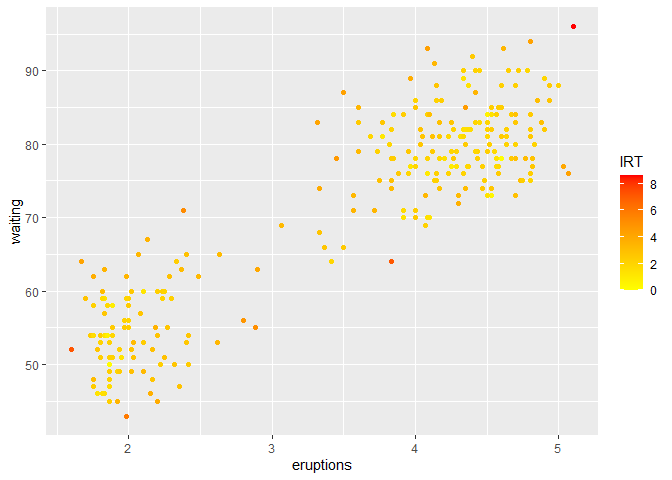
Then we do the greedy ensemble.
ens2 <- greedy_ensemble(Y)
df <- cbind.data.frame(faithful, ens2$scores)
colnames(df)[3] <- "Greedy"
ggplot(df, aes(eruptions, waiting)) + geom_point(aes(color=Greedy)) + scale_color_gradient(low="yellow", high="red")
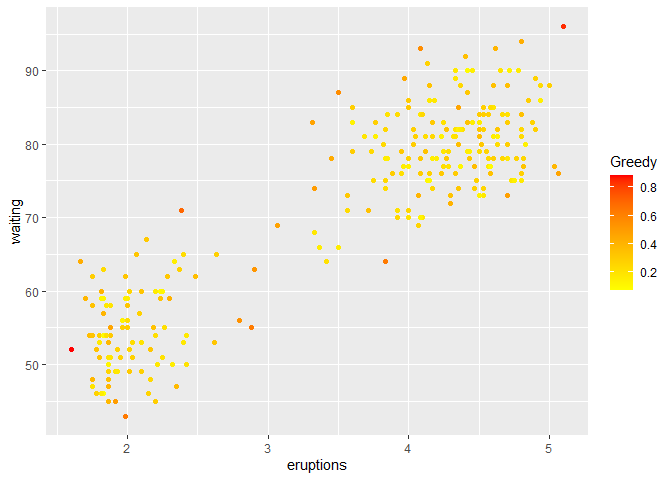
We do the ICWA ensemble next.
ens3 <- icwa_ensemble(Y)
df <- cbind.data.frame(faithful, ens3)
colnames(df)[3] <- "ICWA"
ggplot(df, aes(eruptions, waiting)) + geom_point(aes(color=ICWA)) + scale_color_gradient(low="yellow", high="red")
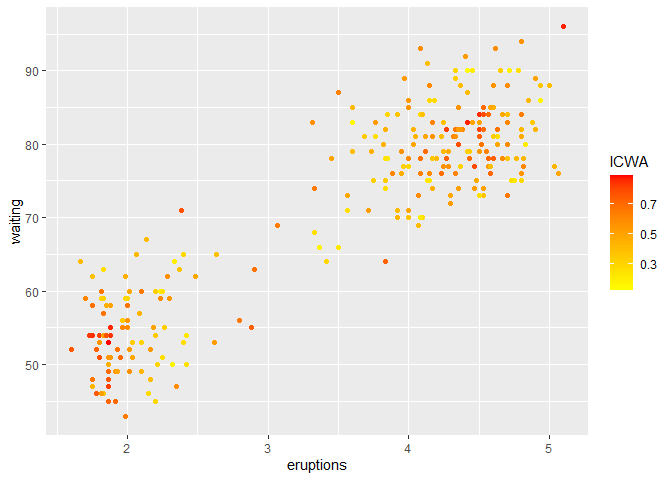
Next, we use the maximum scores to build the ensemble.
ens4 <- max_ensemble(Y)
df <- cbind.data.frame(faithful, ens4)
colnames(df)[3] <- "Max"
ggplot(df, aes(eruptions, waiting)) + geom_point(aes(color=Max)) + scale_color_gradient(low="yellow", high="red")
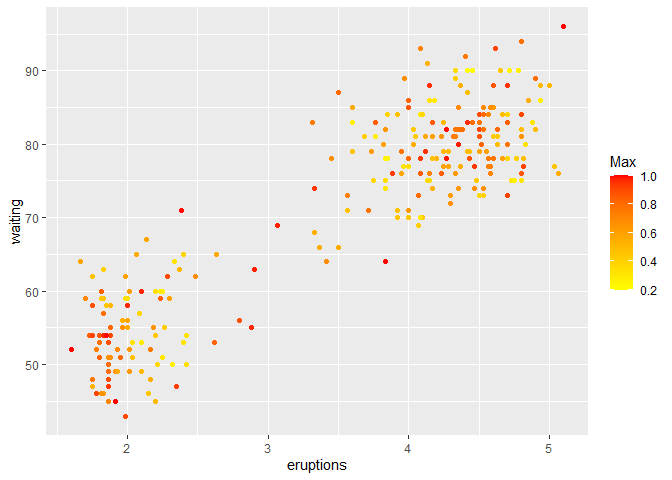
Then, we use the a threshold sum to construct the ensemble.
ens5 <- threshold_ensemble(Y)
df <- cbind.data.frame(faithful, ens5)
colnames(df)[3] <- "Threshold"
ggplot(df, aes(eruptions, waiting)) + geom_point(aes(color=Threshold)) + scale_color_gradient(low="yellow", high="red")
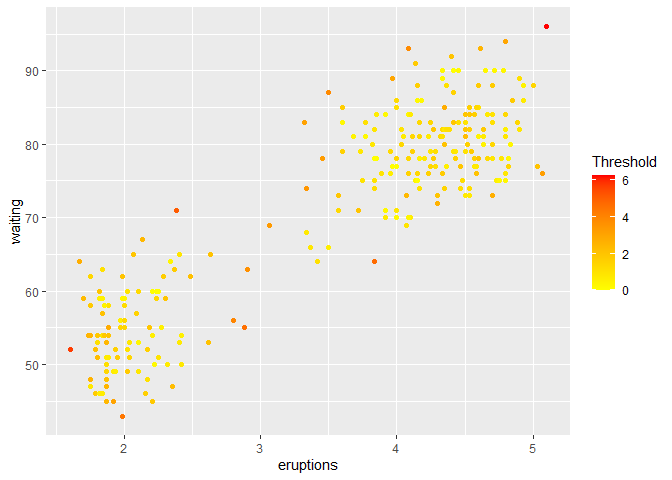
Finally, we use the mean values as the ensemble score.
ens6 <- average_ensemble(Y)
df <- cbind.data.frame(faithful, ens6)
colnames(df)[3] <- "Average"
ggplot(df, aes(eruptions, waiting)) + geom_point(aes(color=Average)) + scale_color_gradient(low="yellow", high="red")
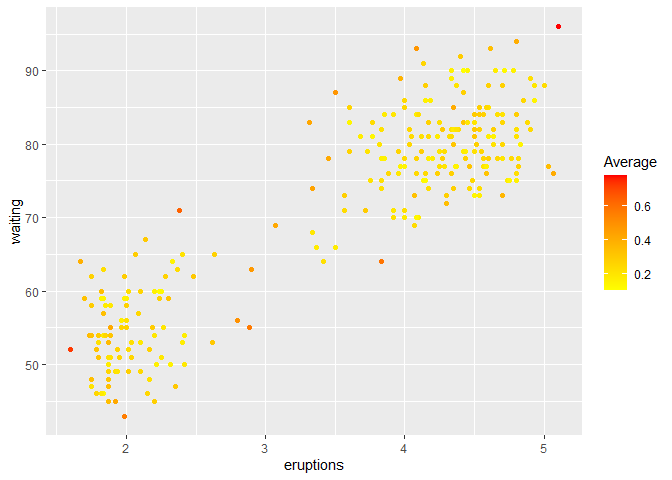
References
Aggarwal, Charu C., and Saket Sathe. 2015. “Theoretical Foundations and Algorithms for Outlier Ensembles.” ACM SIGKDD Explorations Newsletter 17 (1): 24–47. https://doi.org/10.1145/2830544.2830549.
Chiang, Alvin et al. 2017. “A study on anomaly detection ensembles.” Journal of Applied Logic 21: 1–13. https://doi.org/10.1016/j.jal.2016.12.002.
Kandanaarachchi, Sevvandi. 2022. “Unsupervised Anomaly Detection Ensembles Using Item Response Theory.” Information Sciences 587: 142–63. https://doi.org/https://doi.org/10.1016/j.ins.2021.12.042.
Schubert, Erich, Remigius Wojdanowski, Arthur Zimek, and Hans Peter Kriegel. 2012. “On evaluation of outlier rankings and outlier scores.” In Proceedings of the 12th SIAM International Conference on Data Mining, SDM 2012, 1047–58.